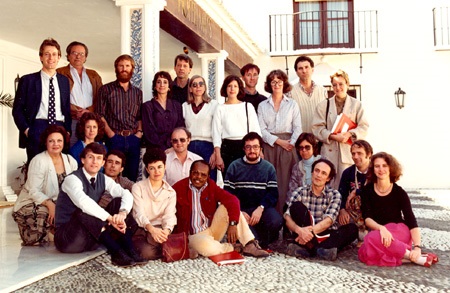Sepik Culture History: Variation and Synthesis
Date
Feb 15-23, 1986Organized by
Anthony ForgeLocation
Hotel Mijas, Mijas, SpainPublications
Sepik Heritage: Tradition and Change in Papua New Guinea (N. Lutkehaus, C. Kaufmann, W.E. Mitchell, D. Newton, L. Osmundsen, M. Schuster, Eds.) Carolina Academic Press, Durham, North Carolina, 1990.Participants
- Bryant J. Allen Australian National University
- Frederick Errington Keene State College, USA
- Colin S. Filer University of Papua New Guinea
- William A. Foley Australian National University
- Anthony Forge Australian National University
- Deborah Gewertz Amherst College, USA
- Simon J. Harrison University of Ulster, UK
- Brigitta Hauser-Schaublin Museum fur Volkerkunde, Switzerland
- Gilbert Lewis University of Cambridge, UK
- Shirley Lindenbaum New School for Social Research, USA
- David Lipset University of Minnesota, USA
- Nancy Lutkehaus University of Southern California, USA
- Nancy McDowell Franklin and Marshall College, USA
- Otto Nekitel University of Papua New Guinea
- Lita Osmundsen Wenner-Gren Foundation, USA
- Paul Roscoe University of Maine, USA
- Richard Scaglion University of Pittsburgh, USA
- Markus Schindlbeck Museum fur Volkerkunde, West Germany
- Milan Stanek National Museum Houseboat, Papua New Guinea
- Pamela Swadling Papua New Guinea National Museum
- Jason Williams New York University, USA
ORGANIZER’S STATEMENT: The conference focused on innovation and creativity, using as its vehicle the Sepik region of Papua New Guinea. This area is renowned for a linguistic and cultural diversity surpassing any other culture area in the world, and until recently it was precisely this diversity that was underscored in Sepik research. Yet this tendency toward particularism has always been counterpointed by the existence of certain remarkable regional continuities in the style of its arts. The discussions sought to lay the groundwork for a regional analysis that stresses the unifying forces at work, and to uncover the ecological, demographic and social organizational variables that underpin Sepik cultures. The role played by aesthetics in the making of cultures was highlighted, since the most significant cultures in the region deploy ritual and artistic resources to establish and reinforce their various identities and powers. The conference developed a typology which is being used to generate intra- and interregional comparisons among cultures of the New Guinea mainland.
Wenner-Gren Symposium #101
